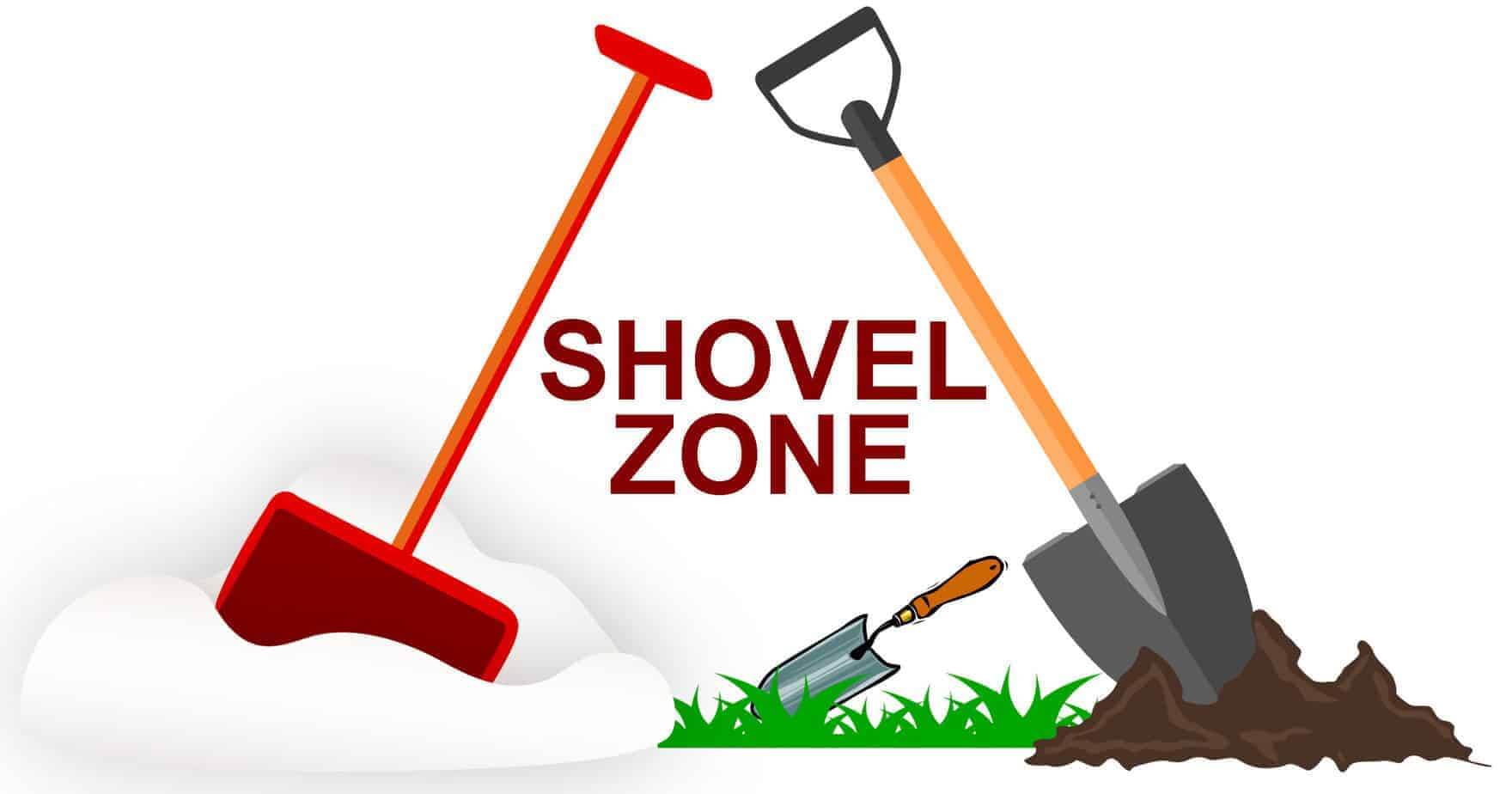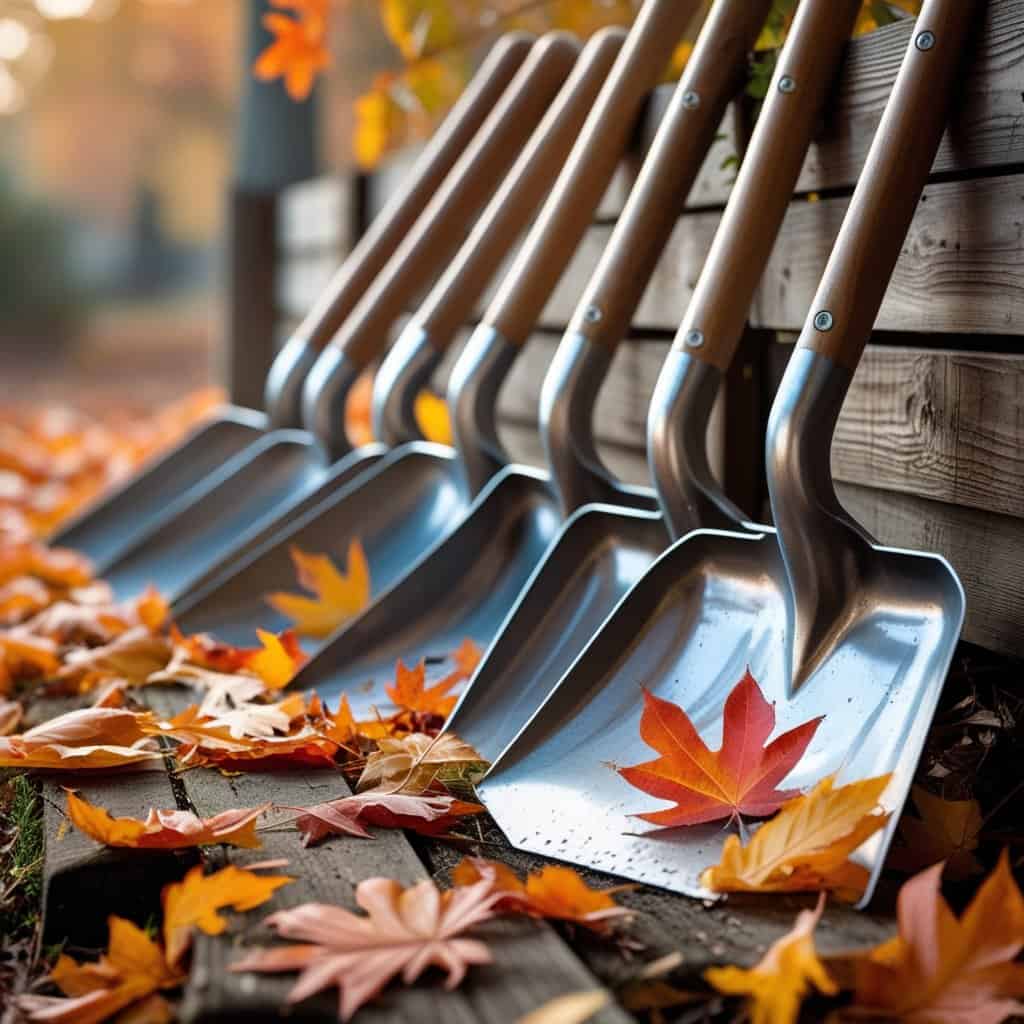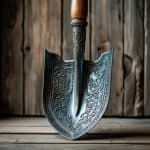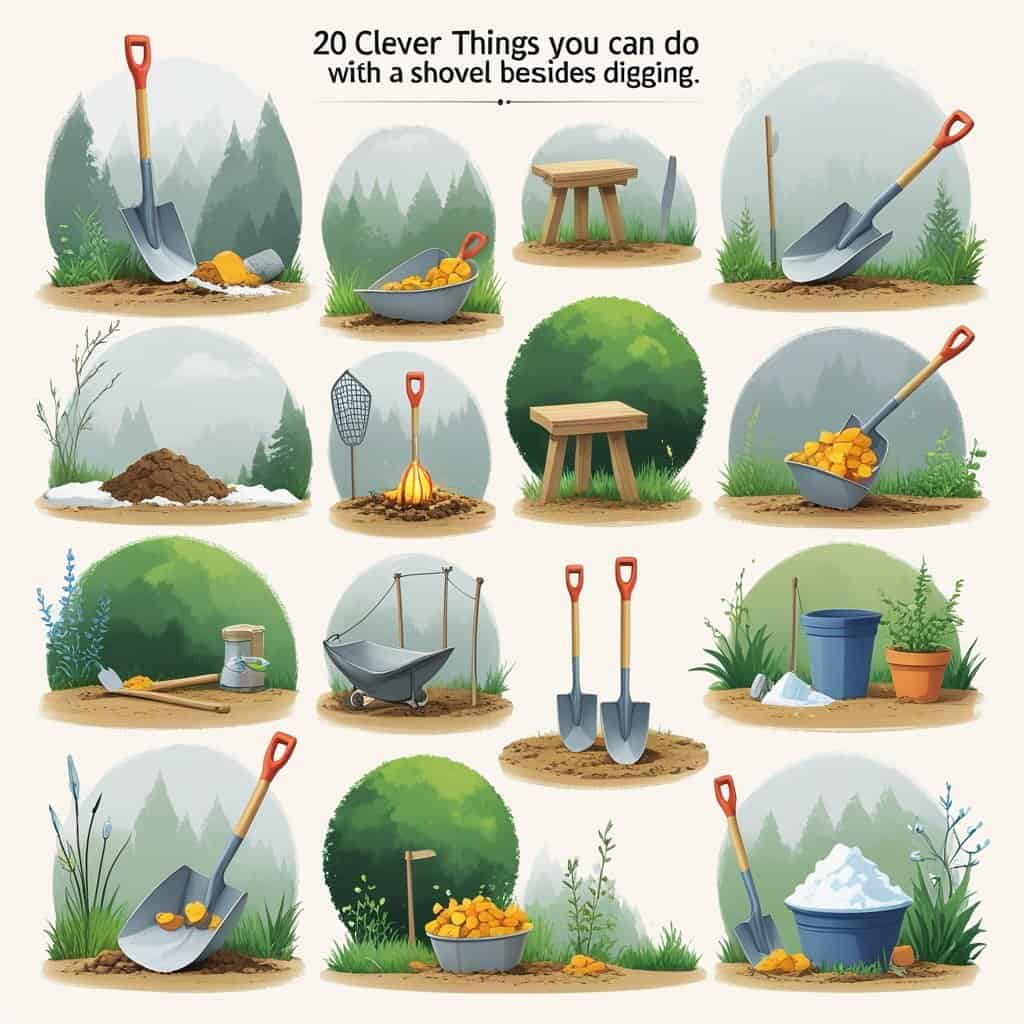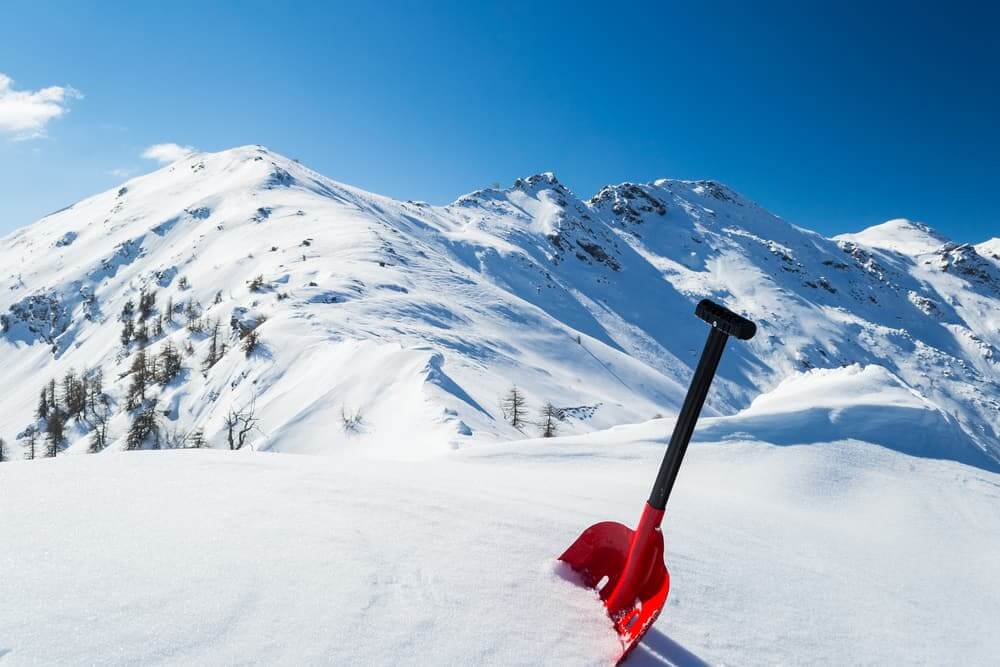When fall leaves pile up across the yard, a shovel can be just as useful as a rake or blower. The best shovels for fall leaf cleanup make it easier to scoop, lift, and move large piles quickly without straining your back.
With the right tool, we can cut down the time spent on this seasonal task and keep our outdoor spaces clear before winter sets in using a shovel for fall leaf cleanup.
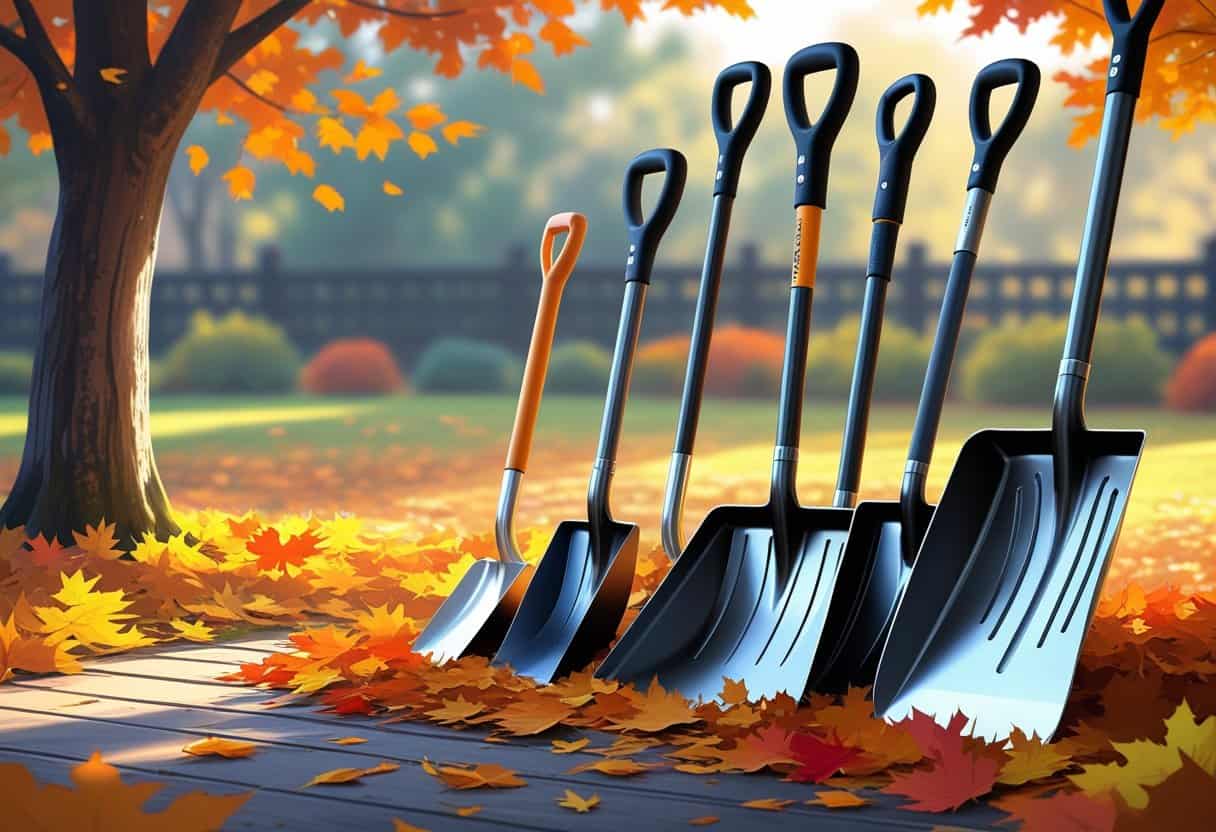
We often think of rakes as the go-to tool for leaves, but shovels designed for yard cleanup offer unique advantages. Wide blades, lightweight materials, and ergonomic handles help us gather and transport leaves more efficiently.
Choosing the right shovel not only saves effort but also makes the entire cleanup process more manageable.
As we explore why the right shovel matters, what types are most effective, and how they compare to other fall tools, we’ll see how a simple upgrade can improve our routine.
By focusing on key features and best practices, we can make leaf cleanup less of a chore and more of a straightforward task.
Table of Contents
Why the Right Shovel For Fall Leaf Cleanup Matters
Choosing the right shovel affects how quickly we move leaves, how much strain we put on our bodies, and how we handle common problems like wet or heavy yard debris.
A proper tool can make fall cleanup more efficient, safer, and less tiring.
Shovels For Fall Leaf Cleanup vs. Other Leaf Removal Tools
Leaf removal can be done with many tools, but each has trade-offs. Rakes are lightweight and inexpensive, while blowers move leaves fast but are noisy and require fuel or electricity.
Vacuums collect and mulch leaves but can be heavy and costly. A shovel offers a balance between simplicity and power.
With a wide blade, we can scoop large piles of leaves at once. Unlike a blower, a shovel doesn’t rely on fuel or batteries, making it more sustainable.
For small to medium yards, a shovel can replace multiple tools. In larger spaces, it works best when paired with a rake to gather leaves into piles first.
Some experts recommend leaf shovels with ergonomic designs to reduce strain during yard cleanup.
Impact on Efficiency and Ergonomics
The right shovel makes fall yard work faster and less stressful. A wide, lightweight blade allows us to lift more leaves with fewer motions.
Handles with ergonomic grips reduce hand fatigue and help us maintain better posture. Efficiency also comes from technique.
When we bend at the knees instead of the waist, we protect our backs. Using steady, small scoops instead of overloading the shovel prevents overexertion.
A good shovel can also reduce the number of passes needed to clear yard debris. Combined with proper body mechanics, the right tool saves time and energy.
Common Challenges with Leaf Cleanup
Leaves present unique challenges depending on their condition. Wet leaves are heavy and stick together, making them harder to move.
Dry leaves scatter in the wind, requiring us to pile them quickly before they blow away. Uneven surfaces, such as gravel driveways or garden beds, complicate leaf removal.
A shovel with a flat edge helps gather leaves without disturbing the ground underneath. Volume is another issue.
During peak fall cleanup, leaves can pile up faster than we can collect them. Using a shovel with a large blade reduces the number of trips to the compost pile or bagging area.
For efficiency, many homeowners combine shovels with tools like rake shovels to handle these challenges more effectively.
Types of Shovels for Leaf Cleanup
When we choose the right shovel for fall cleanup, the design and size matter most. The shape of the blade, the handle style, and the material all affect how easily we can move piles of leaves and other yard debris.
Standard Shovels
Standard shovels are the most common type found in most garages or sheds. They have a straight handle and a rounded or pointed blade.
While they work well for digging soil, they are less efficient for scooping lightweight materials like dry leaves. We can still use them for small piles of leaves or when mixing in soil and compost.
Their sturdy design also helps when leaves are wet and stuck to the ground. However, they cover less surface area compared to wider scoop shovels.
Standard shovels are best for mixed yard debris cleanup when we need one tool for different tasks. They are not the fastest option for large leaf piles, but they are reliable and versatile.
Scoop Shovels
Scoop shovels have a wide, flat blade that makes them ideal for moving large amounts of lightweight material. The blade is often made of aluminum or plastic, which keeps the tool light and easy to handle.
For fall cleanup, scoop shovels let us lift and move leaves quickly. A single scoop can hold more volume than a standard shovel.
This makes them useful when transferring leaves from a tarp into bags or bins. We should choose a scoop shovel with a strong handle and a comfortable grip.
Some models, like the Razor-Back D-Handle Aluminum Scoop, are designed to handle wet leaves without bending or rusting.
Ergonomic and Specialty Shovels
Ergonomic and specialty shovels are designed to reduce strain and improve efficiency. They often feature a D-handle or bent shaft that gives us better leverage and control.
These designs make lifting and tossing leaves easier on the back and wrists. Specialty leaf shovels usually have extra-wide blades.
This allows us to scoop wet, heavy leaves or mixed yard debris with fewer motions. Some are made from rust-resistant aluminum, while others use reinforced plastic for lighter handling.
We can also find dual-handle designs that let us use both hands for more power. These shovels are especially useful when leaves are matted down or mixed with soil.
Comparing Shovels to Other Essential Fall Tools
Shovels handle heavy lifting and scooping, but other tools can be more efficient for moving, collecting, or breaking down leaves. Each option works best in certain situations, and knowing when to use them helps us save time and effort during fall yard work.
Leaf Rake and Its Uses
A leaf rake is often the first tool we grab when leaves start piling up. It spreads wide, which makes it quick to gather large amounts of dry leaves.
Unlike a shovel, a rake doesn’t lift heavy material well, but it excels at pulling leaves into neat piles. We can choose between plastic rakes for lighter use and steel rakes for tougher jobs.
Wider heads cover more ground, while narrow rakes fit into tighter spaces. Shovels may scoop better, but rakes remain the best tool for spreading and collecting leaves across lawns without disturbing the grass.
For example, a rake works well on uneven areas where shovels would dig into the soil. Once the leaves are piled, we can switch to a shovel or bagging tool to finish the cleanup.
Leaf Blower vs. Shovel
A leaf blower clears large areas faster than a shovel. Blowers push leaves into piles using air power, which is especially useful on driveways, patios, and wide lawns.
Shovels are stronger at picking up piles, but they can’t move scattered leaves across big spaces as quickly. We can choose between gas, corded, or cordless blowers, depending on yard size and noise concerns.
Cordless blowers give flexibility, while gas models handle larger properties. Unlike shovels, blowers don’t require lifting, which reduces strain on our backs.
However, blowers may scatter leaves in windy conditions, where a shovel offers more control. For best results, we often use both: blowers for gathering and shovels for scooping.
A leaf blower can save time, but it doesn’t fully replace the shovel’s role.
Advantages of Leaf Vacuums and Lawn Sweepers
A leaf vacuum collects and sometimes mulches leaves at the same time. This makes disposal easier because the leaves take up less space.
Compared to shovels, vacuums reduce bending and lifting, which helps when we deal with large amounts of debris. A lawn sweeper works like a push or tow-behind rake.
It brushes leaves and grass clippings into a hopper, making it efficient for big yards. Unlike shovels, sweepers cover wide areas quickly without heavy effort.
Both tools are more specialized than shovels. A shovel is still useful for scooping piles into bags, but vacuums and sweepers reduce the number of piles we need to handle.
For large properties, these tools save significant time during fall yard work.
When to Use a Mulching Mower
A mulching mower or mulching lawn mower chops leaves into fine pieces and spreads them back into the grass. This method avoids bagging and hauling altogether.
Shovels can’t perform this task, making mulching mowers unique in their role. We should use mulching mowers when the leaf layer is thin to moderate.
Too many leaves at once can clog the mower and leave clumps. A light mulching session every few days works better than waiting until the yard is buried.
Mulched leaves decompose quickly, adding nutrients to the soil. This reduces waste and improves lawn health.
Key Features to Look for in a Shovel for Leaf Cleanup
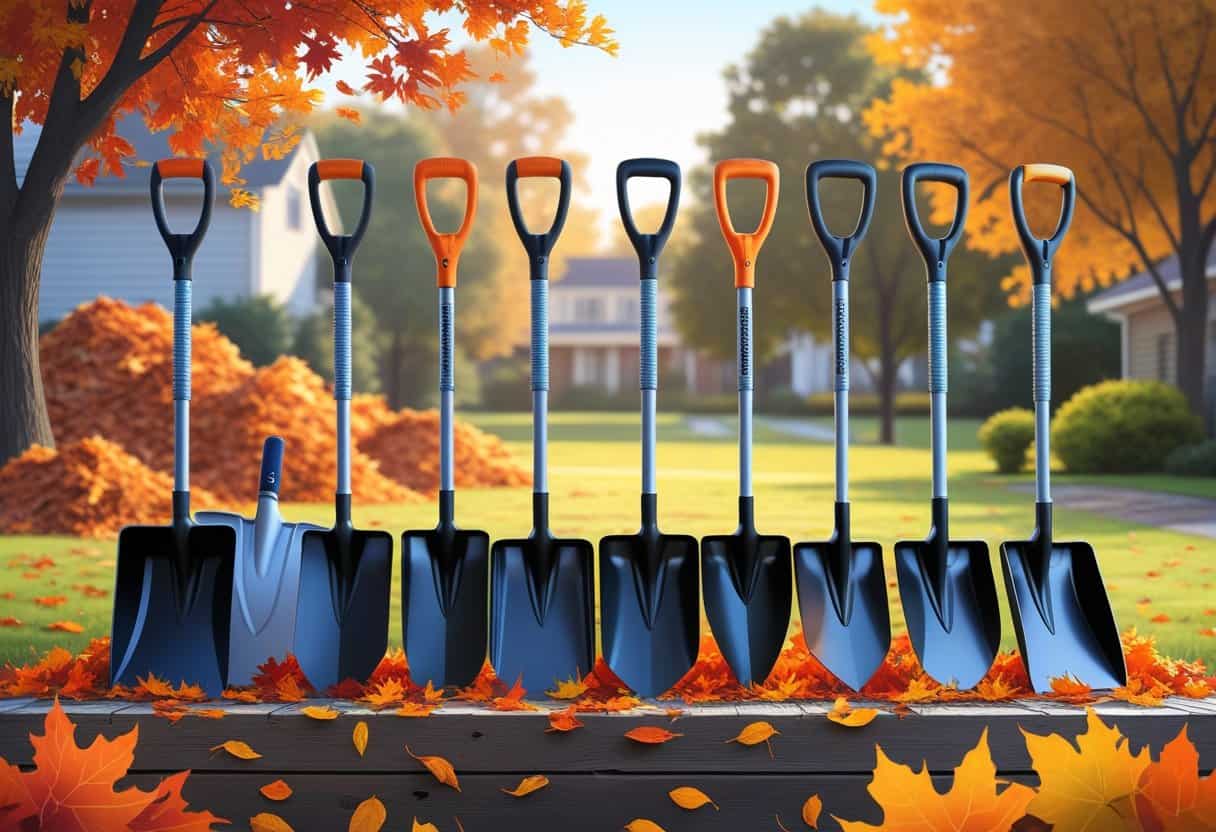
When we choose a shovel for handling leaves and yard debris, the right design can make fall cleanup faster, safer, and more comfortable. The shape of the blade, the handle, the balance, and the durability all affect how well the tool performs over time.
Blade Shape and Size
The blade determines how much material we can move at once. A wide, flat blade works best for scooping lightweight leaves, while a narrower blade is more effective for heavier or damp yard debris.
Plastic blades are often lighter and easier to maneuver, making them useful for dry leaves. Metal blades, on the other hand, provide more strength when dealing with wet or compacted piles.
We should also consider the edge of the blade. A slightly curved edge helps gather leaves without spilling, while a straight edge provides more control on flat surfaces like driveways.
Quick comparison:
- Wide blade: moves more leaves, less control
- Narrow blade: better for heavy or wet debris
- Curved edge: holds leaves securely
- Straight edge: precise, good for hard surfaces
Handle Design and Material
The handle plays a big role in comfort and control. A long handle reduces the need to bend, which helps protect our back during long cleanup sessions.
Shorter handles give more leverage in tight spaces. Wood handles are sturdy and traditional, but they can become heavy after extended use.
Fiberglass handles are lighter and resist weather damage. Aluminum handles balance strength with reduced weight.
We should also look for ergonomic grips. A padded or textured grip reduces slipping and hand fatigue.
Some shovels include a secondary grip near the blade for added control when lifting piles of leaves.
Handle options to note:
- Wood: strong, heavier, may splinter
- Fiberglass: light, weather resistant
- Aluminum: durable, less weight
- Ergonomic grips: improve comfort and reduce strain
Weight and Balance
Weight affects how long we can work without tiring. A lighter shovel helps us move quickly, but if it is too light, it may not handle wet leaves or mixed yard debris effectively.
Balance is just as important as weight. A well-balanced shovel feels stable in our hands and reduces the strain on wrists and shoulders.
Poorly balanced tools can make fall cleanup harder than it needs to be. We should test how the shovel feels when lifting and tossing leaves.
If the weight is unevenly distributed, it will require more effort to control. A balanced tool lets us work longer with less fatigue.
Durability and Maintenance
Durability ensures the shovel lasts through multiple fall seasons. Metal blades and reinforced handles handle heavy use better than cheaper plastic models.
Lightweight plastics can still be effective if we only deal with dry leaves. Maintenance also extends the life of the tool.
Regular cleaning prevents dirt buildup, and storing the shovel in a dry place reduces rust and wear. Some shovels may need blade sharpening to maintain efficiency.
We should check for strong connections between the blade and handle. Loose fittings reduce performance and can lead to breakage.
A shovel built with quality materials and proper care will remain reliable for many years of fall cleanup.
Best Practices for Efficient Fall Leaf Removal
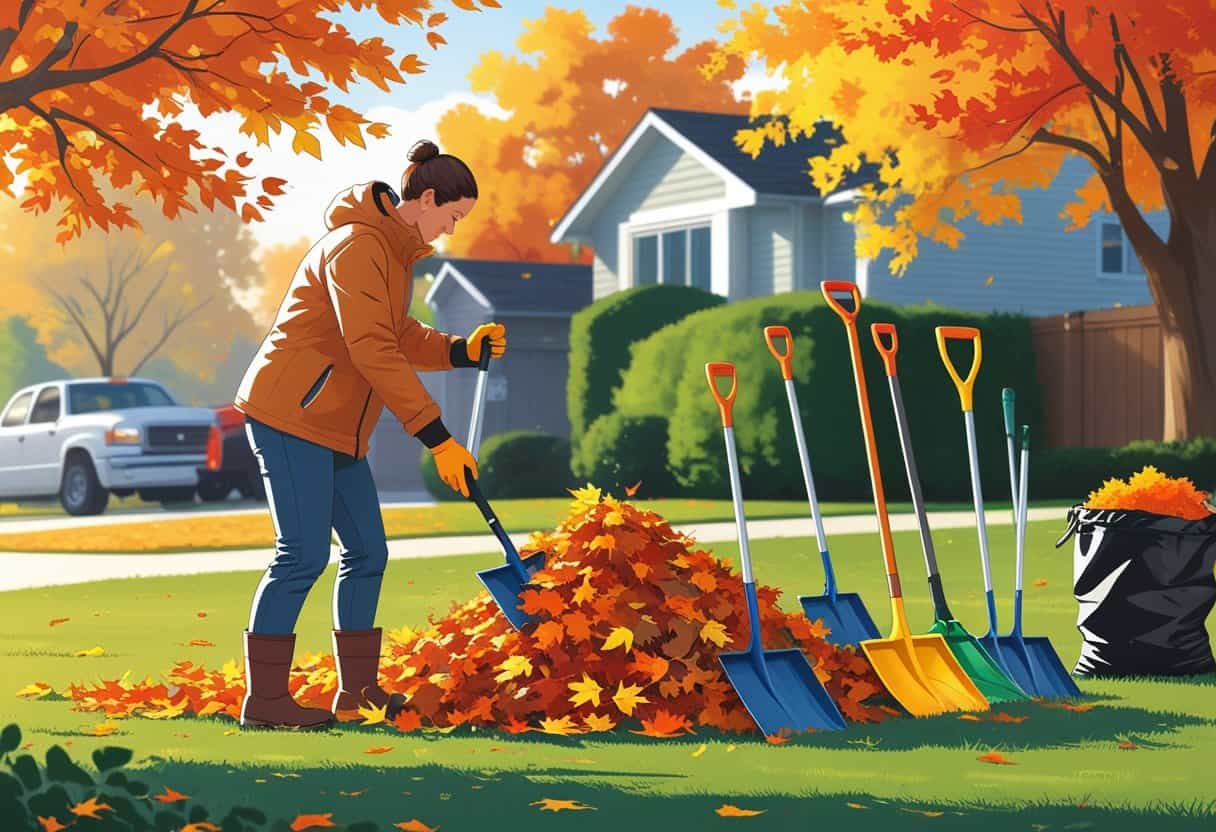
We can make fall yard work more efficient by combining the right tools with safe techniques and proper gear. Using shovels with tarps or leaf chutes speeds up collection, while good habits and protective equipment reduce strain and injury during yard cleanup.
Pairing Shovels with Tarps and Leaf Chutes
When we scoop leaves with a shovel, moving them directly into a bag can be slow. A leaf tarp or leaf chute makes this process faster and more organized.
Tarps allow us to drag large piles across the yard, while chutes keep bags open and stable. For medium or large yards, a tarp can hold several wheelbarrows of leaves.
Folding the tarp like a pouch makes dumping easier. A leaf chute helps when working alone, since it prevents bags from collapsing.
We can shovel or rake leaves straight in without holding the bag open. By pairing shovels with these accessories, we cut down on repeated trips and reduce bending.
Safety Tips and Proper Technique
Using a shovel for leaves may seem simple, but poor technique can lead to back or shoulder pain. We should bend at the knees, not the waist, and keep the load close to our body when lifting.
Smaller scoops are safer than overloading the shovel. When dragging a tarp, we should pull with both hands and walk forward instead of twisting.
If the leaves are wet, they will be heavier, so it’s best to let them dry before scooping. Taking short breaks prevents fatigue and makes the work steadier.
We also need to maintain clear walkways. Wet leaves can be slippery, so we should avoid stacking piles on driveways or paths.
Protective Gear for Fall Yard Work
Proper gear makes yard cleanup safer and more comfortable. Garden gloves protect our hands from blisters, sharp sticks, and damp leaves.
Gloves with a textured grip also make it easier to handle shovels, tarps, and bags. Wearing sturdy shoes or boots prevents slips on wet grass or pavement.
Long sleeves and pants protect against scratches from branches or hidden debris in leaf piles. For those using blowers or vacuums along with shovels, ear protection may be necessary.
Eye protection is also useful when scooping near shrubs or when wind stirs up dust. With the right gear, we can handle fall yard work more comfortably and with less risk.
Frequently Asked Questions
What features should I look for in a shovel for efficient leaf cleanup?
We should look for wide blades that can scoop large amounts of leaves at once. Lightweight construction helps reduce strain, while a sturdy handle provides better control.
Non-slip grips also improve handling during longer cleanup sessions.
What materials are best for shovels meant for clearing leaves and maintaining sharpness?
Aluminum and reinforced plastic are both lightweight and durable, making them good for leaf cleanup. Steel edges can add strength, but they are heavier.
Choosing the right material depends on whether we need speed, durability, or a balance of both.
Are there multipurpose shovels that are good for leaves but also versatile for other garden tasks?
Yes, some multipurpose designs combine wide blades for leaves with reinforced edges for soil or mulch.
Tools like those in this fall cleanup guide can handle both seasonal leaf removal and general yard maintenance.
